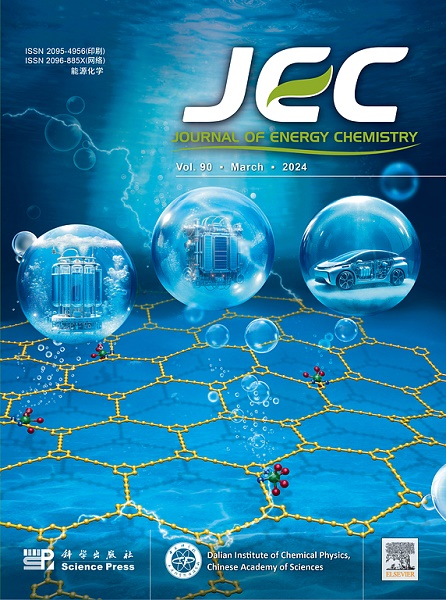Constructing P–O bridge at heterogeneous interface to enhance built-in electric field to facilitate the surface reconstruction of carbon coated OER catalyst
IF 13.1
1区 化学
Q1 Energy
引用次数: 0
Abstract
Constructing heterostructures and facilitating surface reconstruction are effective ways to obtain excellent catalysts for the oxygen evolution reaction (OER). Surface reconstruction is a dynamic process that is affected by the built-in electric field of the heterostructure. In this study, P/N co-doped carbon-coated Ni-Co/Ni-CoO heterostructure was prepared by in situ acid etching, aniline polymerization, and pyrolysis. This method can form a tightly connected heterogeneous interface. It was found that introducing P–O bonds in the carbon shell can increase its work function, thereby enhancing the built-in electric field between the carbon shell and the core catalyst. Detailed characterizations confirm that the P–O bridge at the heterogeneous interface can provide an electron flow highway from the core to the shell. The generated carbon defects generated by P leaching during surface reconstruction also have strong electron-absorbing capacity. These effects promote the conversion of Co2+ to Co3+, thereby providing more highly active sites. The resulting catalyst shows significantly enhanced activity and stability. This study demonstrates the promoting effect of the built-in electric field on the surface reconstruction of the catalyst and emphasizes the importance of the construction of tightly connected heterogeneous interface, which is instructive for the design of excellent OER catalysts.

求助全文
约1分钟内获得全文
求助全文
来源期刊

Journal of Energy Chemistry
CHEMISTRY, APPLIED-CHEMISTRY, PHYSICAL
CiteScore
19.10
自引率
8.40%
发文量
3631
审稿时长
15 days
期刊介绍:
The Journal of Energy Chemistry, the official publication of Science Press and the Dalian Institute of Chemical Physics, Chinese Academy of Sciences, serves as a platform for reporting creative research and innovative applications in energy chemistry. It mainly reports on creative researches and innovative applications of chemical conversions of fossil energy, carbon dioxide, electrochemical energy and hydrogen energy, as well as the conversions of biomass and solar energy related with chemical issues to promote academic exchanges in the field of energy chemistry and to accelerate the exploration, research and development of energy science and technologies.
This journal focuses on original research papers covering various topics within energy chemistry worldwide, including:
Optimized utilization of fossil energy
Hydrogen energy
Conversion and storage of electrochemical energy
Capture, storage, and chemical conversion of carbon dioxide
Materials and nanotechnologies for energy conversion and storage
Chemistry in biomass conversion
Chemistry in the utilization of solar energy
 求助内容:
求助内容: 应助结果提醒方式:
应助结果提醒方式:


